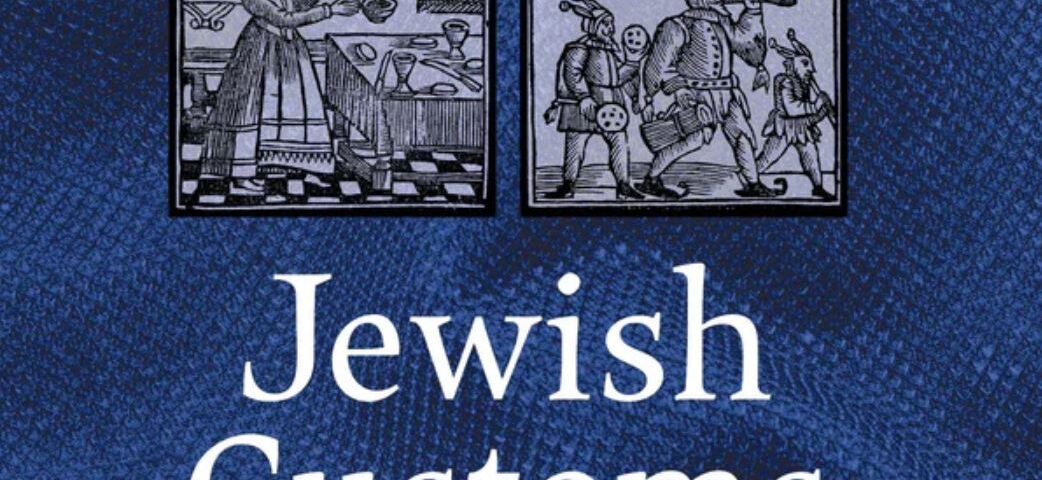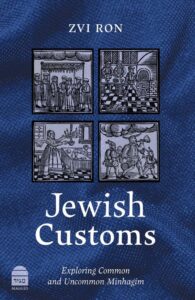REVIEW: Jewish Customs

 Zvi Ron, Jewish Customs: Exploring Common and Uncommon Minhagim (Maggid Press, 2024), 465 pages.
Zvi Ron, Jewish Customs: Exploring Common and Uncommon Minhagim (Maggid Press, 2024), 465 pages.
[I]n recent years that there has been a growing interest in how customs developed over time, and what influences shaped their development. Rather than taking the custom as a given, researchers now focus on exploring the origin of the custom, the way in which it has been transmitted and popularized, and how it has changed over time, in an attempt to understand how the customs we are familiar with today came to be (xiii).
Rabbi Dr. Zvi Ron aptly places his Jewish Customs: Exploring Common and Uncommon Minhagim along many works over the previous decades that take the study of custom seriously, seeking to historically source these practices, as well as shed light on the changing interpretation of those customs over time. The book is a collection of essays, and as Ron notes, is not intended to present a coherent theme. Rather, as he writes, it covers subjects that “were chosen simply because I was curious about or had been asked about these topics, but I could not find a satisfactory treatment of them in the existing literature” (xiv). For each of those twenty-seven customs, divided into categories of life cycle, Shabbat and the cycle of the year, and liturgy, Ron’s meticulous research and clear writing will offer the reader an invaluable resource for those asking the questions that drove him. Furthermore, as one of my mentors told me, people like learning from those who are having fun – so teach what you enjoy. Ron’s fascination with these topics is evident, and that interest can be contagious for his readers who have never thought about these issues. One can happily take Ron’s advice to “enjoy the fruit of my labor and research, and discover new insights about customs both familiar and arcane” (xiii).
As the title of the book notes, the topics range from customs that are widely known, such as the recitation of an expanded Tahanun on Mondays and Thursdays (chapter 18), and the bride’s circling of the groom at weddings (chapter 1 [available online]), to those that are more obscure, such as Hai Rotel on Lag Ba-Omer (distributing eighteen drinks at Meron), though he notes this has recently become more common. He also includes customs that have mostly fallen out of practice, such as not slaughtering geese during the months of Tevet and Shevat (chapter 12). There are also chapters that relate to customs that are widely (though not universally) practiced, such as the recitation of the four Megillot, aside from Esther, on holidays throughout the year. In addition, he explores practices found in only certain communities (chapter 26), and those that are limited to a subsection of a community, such as the recitation of Al Tira after Aleinu (chapter 20).
Some chapters are particularly effective at not just surveying various suggested sources for customs, but critically analyzing the data and making cogent arguments for their true origin. For example, chapter 3 about covering mirrors in a Shiva home, begins with “classic rabbinic explanations” that connect this well-known custom to the no longer observed kefiyat ha-mita, turning over the beds (as the latter relates to forbidden marital relations during the week of mourning, and mirrors allow one to improve one’s appearance and appeal, or, alternatively, both point to the diminishment of a person created in the image of God), or practical reasons like the need to pray in a house of mourning and the prohibition of praying in front of mirrors. These “traditional” suggestions are comfortable but not compelling. Ron expertly shows that the custom more likely was adopted from non-Jewish superstitions, such as the belief that the souls of the deceased can be drawn into reflections. In other essays, such as that concerning the bride circling the groom, while he does trace reasons for the custom over time, he focuses less on finding the origin of the minhag. As the articles in the book were published separately over the course of years, in journals with different audiences, some stylistic divergence is to be expected, and there’s no one coherent theme running throughout the book. However, his conclusion sets forth some organizing principles (one wonders why this wasn’t presented at the opening). Despite his attempt to locate original rationales for customs in certain chapters, he notes that many customs developed in multiple directions at the same time, and thus there may not be one authentic way of practicing (or interpreting) them. Thus, he warns against the “allure of the definite” (383-384). This welcome note of caution ensures that the reader embraces the multilayered meaning that can be derived from and infused into customs.
One part of the book that would have benefited from expansion is the treatment of hukkat akum (the prohibition of mimicking the ways and practices of other nations). Take, for example, the chapter on covering mirrors in the house of mourning. As noted, Ron convincingly suggests this emerged from superstitious and perhaps idolatrous beliefs of non-Jewish cultures. I, for one, was shaken by the sanguine acceptance of the claim that, “Although it is in fact non-Jewish in origin, and based on the superstition that souls of the deceased can be drawn into reflections, the real origins of the custom have been forgotten, and covering mirrors is now widely considered one of the signature symbols of Jewish mourning” (46). Yet less than three pages in the book (388-390) are devoted to the definition of the prohibition of hukkat akum. While there are debates as to its definition and scope, as Ron notes, Rama (Y.D. 188:1) follows Maharik (88) in prohibiting all practices that might have had an idolatrous background. Some of the customs analyzed in this book are shown to quite plausibly fall in this category. Ron suggests a novel defense:
My understanding is that they were not considered that way to the communities who originally practiced them. A superstition is an irrational practice, but in earlier times, when the world appeared to be filled with many unknown and incomprehensible forces, conventions that we regard as superstitions today made some kind of sense…. With this understanding of hukkat akum, we can say that the prohibition applies to adopting a non-Jewish practice in a time and place where it has been demonstrated to be superstitious. In the case of covering mirrors, for example, by the time it could be viewed by people as a groundless superstition it had received rabbinic interpretations, recasting the practice as symbolic of ideas consistent with Jewish views of death and mourning. Thus, while clearly originating as a cross-cultural practice now understood according to our modern scientific views to be superstition, the custom to cover mirrors has become infused with new meaning, and survives today as a “Jewish” custom” (388-389).
This is a shocking understanding. Rama writes that any custom with no known origin is forbidden because it might have idolatrous origins, for “we must be concerned for the ways of the Amorites and that it has a trace of idolatry from their ancestors.” If, as Ron contends, some practices certainly had problematic origins, these should be forbidden. Yet, nowhere in the book does Ron reject a single custom.
Ron notes that the Vilna Gaon (Y.D. 178:7) is more stringent and forbids any custom learned from the other nations. Even according to this view, however, Ron defends such customs on the grounds that their practitioners did not adopt them because of the non-Jewish cultural origin, but because they shared the superstitions! In the case of covering the mirrors, “Jews did not cover mirrors in order to copy the mourning rituals of their non-Jewish neighbors; they did it to protect themselves and the deceased from negative spiritual elements, which they understood as a fact of their reality” (389-390). To my mind, these defenses have almost entirely emptied the prohibition of hukkat akum of its relevance. If careful historical research identifies problematic origins of customs, something that Rama insisted was the reason to forbid customs of even unknown origin, more work must be done to justify not reaching such conclusions.
For anyone who wants to learn about the many minhagim Rabbi Dr. Zvi Ron treats, Jewish Customs will be a valuable resource. This author looks forward to a future work where he uses his prodigious research skills to return to the issue of hukkat akum, to continue the intriguing question with which he ends his book: “What makes a custom Jewish?”
Jonathan Ziring, a rosh yeshiva at Migdal HaTorah in Modiin, recently authored Torah in a Connected World.
